Electrical Hazzards
Whilst performing our duties we often stumble upon some quite alarming situations. We have created this page to highlight some of the most dangerous and hazardous electrical faults, workmanship, installation errors or just outright dangerous conditions that occur. We have provided an insight with each image to clarify the correct method. If any of these images reflect a problem that exists within your installation, then we recommend that you contact an electrical engineer as soon as possible to rectify the issue.






Halls of Shame....
Earth, Eddie Currents & Fuseboard downgrade...
1st October 2013
There were so many issues with this installation, not just at the mains but also throughout the entire house, which made a rewire the only real course of action. Believe it or not this image depicts a very common situation that exists within many older installations, (25 years old). The initial reason were call to this installation, was the tennant was complaining that they were recieving electrical shocks from the light switches.
1: In this image the main tails from the RCD pass into the fuse board via separate holes. This practice is frowned upon as magnetic fields within the cables that pass through each of the metal enclosures holes induce what is known as Eddie currents. The normal practice is that both cables should pass through the same aperture to prevent this occurring.
2: The fuse board used for this installation has a maximum individual fuse rating of 15amps. As you can see the rear shield has been removed from one of the 15amp ways to enable a 30amp fuse carrier to be forced into a 15amp way.
3: No Earthing. This was a TT supply (supplied from overhead cables via a pole outside) with no main Earth stake, No bonding to the incoming water or no bonding to the oil supply.
The suspense might be killing me...
6th October 2013
We think this one explains it's self. The property was under going a major renovation we were asked to provide a fuse board change, as we were testing the installation we stumbled upon this just before the plasterer started to plaster the ceiling.
Sink or swim?...
10th October 2013
This little beauty was found whilst undertaking an Installation Condition Report in a restaurant. Our regulations state that an outlet must be at least 300mm away from the edge of a sink, the same applies to cookers / Hobs. This is to prevent any damage caused by heat or water to undermine the connection plate
Hot Plug
13th November 2013
The 13amp plug top shown in this image was attached to a tumble drier. Its obvious that there is a potential fire hazard, in most cases the average householder would turn the drier on and maybe go out whilst the drier does it job. With a hazard like this in hiding the home owner could be coming home to a pile of ashes. There are two main causes for this situation.
1- Flex gripper not properly griping flex and has allowed it to twist.
2- Loose connection/s causing a high resistance, thus causing it to heat up.
It has become commonplace for PAT testing to take place in work environments and is always worth checking those appliances at home.
Browned off Socket
25th November 2013
This little gem was found after our customer had a water tank leak and the downstairs kitchen socket filled up with water. The main installation was protected by a re-wireable fuse (BS3036) which can take up to 10x fault current before it blows, And that assumes that the fuse wire has not been replaced by a nail or such like...........
Trip wire provides supply for garden lighting and garage
25th March 2014
Whilst undertaking a condition report for this leased property we stumbled upon this prime piece of workmanship. The grey 2.5mm twin and earth running down the wall has been spurred from an upstairs socket directly without any method of isolation. It has been terminated within an IP rated box with no glands, It has then been connected to a 1.5mm cable nicely protected by a conduit, then vary carefully laid across the main foot path at the front of the house and held in place with a pebble. This circuit fed 3 – 150watt garden lights, a 4 – gang extension lead in a IP rated lead box and fed the power / lighting for the garage…….